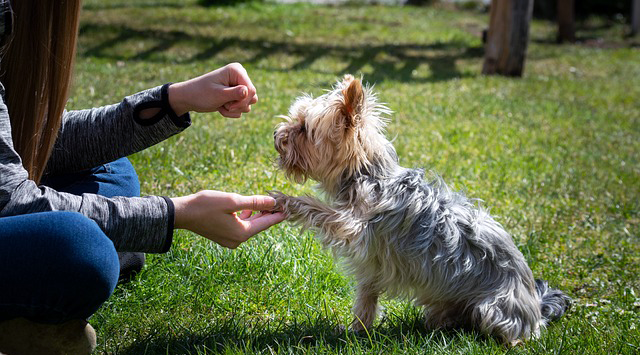
How To Teach Your Dog Basic Commands: SIT, STAY, COME, DOWN & HEEL
LifeSong StaffTraining your dog to obey simple commands such as sit, stay, come, and heel is essential for fostering good behavior, ensuring their safety, and enhancing your bond with them. These basic commands serve as the foundation for more advanced training and can greatly improve communication between you and your canine companion. In this essay, we will explore effective techniques and strategies for teaching your dog these fundamental commands, drawing upon principles of positive reinforcement, consistency, and patience.
Understanding the Importance of Basic Commands
Basic commands play a crucial role in shaping your dog's behavior and establishing a harmonious relationship between you and your pet. Sit, stay, come, and heel are not only useful for everyday interactions but also serve as building blocks for more advanced training tasks and activities. Teaching your dog these commands provides them with structure, clarity, and guidance, ultimately contributing to their overall well-being and obedience.
Positive Reinforcement Training Methods
Positive reinforcement is a highly effective training approach that utilizes rewards such as treats, praise, and affection to reinforce desired behaviors. When teaching your dog basic commands, focus on rewarding them for performing the correct action rather than punishing them for mistakes. Positive reinforcement creates a positive association with the command, making your dog more motivated to obey in the future.
Steps To Teach Your Dog the Sit, Lie Down, Stay, Come, and Heel Commands
How To Train Your Dog To Sit
The sit command is one of the most basic and essential commands for any dog to learn. To teach your dog to sit:
- Start with your dog in a standing position in an environment with minimal distractions.
- Hold a treat close to their nose to capture their attention.
- Slowly move your hand, with the treat, in an arc over your dog's head. As your dog follows the treat with their head, their bottom will naturally lower to the floor.
- As soon as your dog's bottom touches the ground, praise them enthusiastically and give them the treat.
- Remember to introduce the verbal cue "sit" just as your dog begins to lower into the seated position. Ensure you time the cue correctly to avoid confusion.
-
Repeat this process consistently in short, frequent training sessions. With each successful sit, your dog will learn to associate the action with receiving a treat. Continue practicing this exercise regularly to reinforce the behavior.
- Finally, use an "done" cue to signal the end of the training session to your dog.
How To Train Your Dog To Lie Down
- Begin with your dog in a sitting position (in an environment with minimal distractions) and hold a treat in your hand.
- Move your hand from your dog's nose towards their chest, then straight down towards the floor, leading them into a lying down position.
- Immediately praise and reward your dog with the treat once they are lying down.
- Repeat this process in short, regular training sessions to reinforce the behavior.
- Once your dog consistently follows the treat into a down position, introduce the verbal cue "down" just as they begin to lie down.
- While your dog is lying down, continue to reward them with treats to encourage them to remain in that position for longer periods.
- Again you can use the cue "done" to signal the end of the training session.
How To Train Your Dog To Stay
The stay command teaches your dog to remain in a specific position until released. To train your dog to stay:
- Begin with your dog in a sitting or standing position in an environment with minimal distractions.
- Employ a hand signal, such as a 'stop' sign, using your palm facing your dog.
- Rather than immediately providing the treat, introduce a delay of a few seconds. Verbally cue 'stay' before rewarding your dog. Ensure to reward them while they remain in the lying position, not after they've risen.
- Practice this routine frequently in brief yet consistent sessions.
- Progress by increasing the distance between you and your dog. Initially, take only one step back before offering the reward, then gradually extend the distance. Extend the duration of your dog's stay gradually over time, incrementally adding a few seconds during each training session. Be vigilant for signs indicating your dog might break the 'stay' command, and reward them preemptively to reinforce success.
- Again you can use the verbal cue "done" to signal the end of the training session.
- Practice in diverse environments, including indoors, outdoors, at a friend's place, and in public parks.
How To Train Your Dog To Come
The come command is essential for calling your dog back to you, especially in emergencies. To teach your dog to come:
- Begin in a controlled environment with minimal distractions. Make sure you have a treat or toy with you to encourage your do to come to you.
- Run away a few paces from your dog and then get down to your dog's level to say their name followed by the command "come" in a cheerful tone.
- When your dog comes to you, praise them enthusiastically and give them a treat or toy to reward them.
- Back away from your dog while encouraging them to follow you again and again, gradually increasing the distance between you both.
- You can ask a friend or housemate to take turns holding the dog's collar while the other walks far away and then calls the dog over. Remember to praise the dog and offer a treat.
- Practice the come command in various locations and situations, gradually increasing the level of distraction.
How To Train Your Dog The Heel Command
The heel command teaches your dog to walk calmly and closely beside you on a leash, without wandering away or pulling on its leash. To train your dog to heel:
- Start with your dog on a leash and in a sitting position.
- Hold a treat in your hand and position it at your side to encourage your dog to walk beside you. You want your dog close to you, so keep your treat near the side of your body without extending your arm outward.
- Begin walking forward, using the command "heel" in a firm tone.
- Forever every couple of steps your dog walks in stride with you, reward him/her with a treat and a verbal compliment.
- If your dog starts to pull or wander away, call your dog's name and give them the sit command. then you can repeat the process.
- Gradually wait more and more steps before giving your dog a treat; first do it every few steps, then every five steps, and then every ten steps.
Consistency and Patience
Consistency and patience are essential components of successful dog training. Be consistent in your use of commands, rewards, and expectations, and practice training sessions regularly to reinforce learning. Remember that each dog learns at their own pace, so be patient and avoid becoming frustrated if progress is slow. Celebrate small victories and remain positive and encouraging throughout the training process.
Conclusion
Training your dog to obey simple commands such as sit, stay, come, and heel is a rewarding journey that strengthens your bond and enhances your dog's obedience and behavior. By utilizing positive reinforcement techniques, maintaining consistency and patience, and practicing regular training sessions, you can effectively teach your dog these fundamental commands. Remember to tailor your training approach to your dog's individual personality, preferences, and learning style, and always prioritize their safety, well-being, and happiness. With dedication and commitment, you can master the art of training your dog and enjoy a fulfilling and rewarding relationship for years to come.
